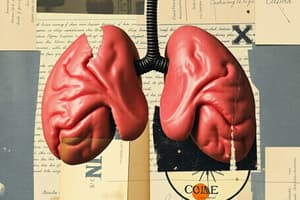Podcast
Questions and Answers
A patient undergoing a hypophysectomy is at risk for meningitis due to the procedure's impact on which of the following?
A patient undergoing a hypophysectomy is at risk for meningitis due to the procedure's impact on which of the following?
- Increased production of cerebrospinal fluid
- Break in the skull base providing direct access to the brain (correct)
- Compromised cardiac function
- Reduced white blood cell count
Which assessment finding is MOST indicative of a cerebrospinal fluid (CSF) leak following a transsphenoidal hypophysectomy?
Which assessment finding is MOST indicative of a cerebrospinal fluid (CSF) leak following a transsphenoidal hypophysectomy?
- Severe hypertension and bradycardia
- Nasal drainage that tests positive for glucose (correct)
- Sudden decrease in level of consciousness
- Increased urine output and thirst
A patient with Cushing's syndrome exhibits hypernatremia and hypokalemia. Which hormone imbalance primarily contributes to these electrolyte disturbances?
A patient with Cushing's syndrome exhibits hypernatremia and hypokalemia. Which hormone imbalance primarily contributes to these electrolyte disturbances?
- Excess aldosterone (correct)
- Excess catecholamines
- Excess cortisol
- Excess androgens
Which nursing intervention is MOST important for a patient post-adrenalectomy to monitor for potential complications related to the highly vascular nature of the adrenal glands?
Which nursing intervention is MOST important for a patient post-adrenalectomy to monitor for potential complications related to the highly vascular nature of the adrenal glands?
A patient with Cushing's syndrome is at increased risk for osteoporosis. Which of the following best explains the mechanism behind this risk?
A patient with Cushing's syndrome is at increased risk for osteoporosis. Which of the following best explains the mechanism behind this risk?
A patient with Cushing's syndrome is scheduled for an adrenalectomy. Preoperatively, which intervention is MOST critical to optimize the patient’s condition?
A patient with Cushing's syndrome is scheduled for an adrenalectomy. Preoperatively, which intervention is MOST critical to optimize the patient’s condition?
Following an adrenalectomy for Cushing's syndrome, a patient is at risk for adrenal insufficiency. What key intervention should the nurse anticipate?
Following an adrenalectomy for Cushing's syndrome, a patient is at risk for adrenal insufficiency. What key intervention should the nurse anticipate?
When educating a patient on the gradual discontinuation of corticosteroids, what is the primary reason for this instruction?
When educating a patient on the gradual discontinuation of corticosteroids, what is the primary reason for this instruction?
A patient with Cushing's syndrome is undergoing a 24-hour urine collection for free cortisol measurement. What should the nurse instruct the patient regarding the procedure?
A patient with Cushing's syndrome is undergoing a 24-hour urine collection for free cortisol measurement. What should the nurse instruct the patient regarding the procedure?
Following a transsphenoidal hypophysectomy, what position should the nurse maintain the patient in to promote venous drainage and reduce edema?
Following a transsphenoidal hypophysectomy, what position should the nurse maintain the patient in to promote venous drainage and reduce edema?
Flashcards
Cushing's Syndrome
Cushing's Syndrome
A condition caused by prolonged exposure to high levels of cortisol.
CRH (Corticotropin-Releasing Hormone)
CRH (Corticotropin-Releasing Hormone)
Hormone secreted by the hypothalamus that stimulates the pituitary gland.
ACTH
ACTH
A hormone produced by the pituitary gland that stimulates the adrenal glands.
Aldosterone Function
Aldosterone Function
Signup and view all the flashcards
Hyperglycemia
Hyperglycemia
Signup and view all the flashcards
Hypernatremia
Hypernatremia
Signup and view all the flashcards
Hypokalemia
Hypokalemia
Signup and view all the flashcards
Adrenalectomy
Adrenalectomy
Signup and view all the flashcards
Hypophysectomy
Hypophysectomy
Signup and view all the flashcards
Cushing's Diet
Cushing's Diet
Signup and view all the flashcards
Study Notes
- Cushing’s syndrome involves excessive levels of corticosteroids, particularly glucocorticoids.
Adrenal Glands and Hormones
- The adrenal glands are located above the kidneys.
- The hypothalamus releases corticotropin-releasing hormone (CRH), stimulating the pituitary gland.
- The pituitary gland then releases adrenocorticotropic hormone (ACTH), which stimulates the adrenal glands.
- Adrenalectomy is the removal of the adrenal gland which is a highly vascular organ, posing a risk of bleeding.
- Post-adrenalectomy care involves regular abdominal assessments and auscultation for bowel sounds.
Hormones Produced by Adrenal Glands
- Cortisol (a glucocorticoid) increases blood sugar and breaks down carbohydrates, proteins, and fats.
- Aldosterone (a mineralocorticoid) regulates blood pressure by retaining sodium and excreting potassium.
- Other hormones produced include androgens (estrogens and testosterone) and catecholamines (epinephrine and norepinephrine).
Problems caused by excess hormones
- Excessive cortisol leads to hyperglycemia.
- Excessive aldosterone leads to high blood pressure, high sodium (hypernatremia), and low potassium (hypokalemia).
- Excess corticosteroids lead to osteoporosis due to increased breakdown.
Causes of Cushing’s Syndrome
- Exogenous corticosteroids are a common cause, especially in patients with asthma, rheumatoid arthritis, or cancer.
- Adrenal tumors and pituitary gland issues can also cause Cushing’s syndrome.
- The pituitary gland is also known as the hypophysis; its removal is called a hypophysectomy.
Manifestations
- Common signs include weight gain, hypertension, and hyperglycemia.
- Fat distribution changes, such as a fat pad (buffalo hump)
- Other manifestations include weakness, loss of collagen, delayed wound healing, mood disturbances, insomnia, irrationality, psychosis, and increased risk of osteoporosis.
- Patients may experience thin arms, purple striae, hypernatremia, and hypokalemia.
- Androgen excess can cause virilization in females and feminization in males.
Diagnostic Studies
- A 24-hour urine test for free cortisol levels (normal range: 80-120).
- Low-dose dexamethasone suppression test for borderline results.
- False positives can occur with depression.
- Plasma cortisol levels may be elevated.
- CT and MRI scans of the pituitary and adrenal glands may be used.
- Suppression tests assess if the adrenal gland continues to produce cortisol despite suppression attempts.
Surgical Interventions
- Hypophysectomy: Removal of the pituitary gland, often performed via a transsphenoidal approach (through the nose).
- Post-surgery care includes monitoring for cerebral spinal fluid leaks and meningitis.
- Patients should be in a semi-Fowler's position post-surgery.
- Open mouth when coughing or sneezing to reduce pressure on the brain.
- Adrenalectomy: Removal of the adrenal gland.
- Post-operative care includes assessing the abdomen, monitoring drainage, and managing NG tube and urine output.
Post-operative care
- After transsphenoidal surgery monitor for edema to the brain cells, increased intracranial pressure/headaches, spikes in fever, and nuecal rigidity(neck pain).
- Monitor cranial nerve 3, edema compressed, pupil size, level of consciousness, drainage.
- If adrenalectomy is being performed due to an adrenal tumor:
Cushing’s Syndrome and Steroid Use
- Prednisone should be gradually discontinued to allow the adrenal gland to recover and secrete hormones.
- Abruptly stopping cortisol can cause patient collapse, low blood pressure, and hypoglycemia.
Symptoms of Cushing’s Syndrome Recap
- Moon face, hypertension, hypernatremia, hypokalemia, protein wasting, risk of bone fractures, poor wound healing, acne, buffalo hump, fluid overload, and weight gain.
Nursing Interventions
- Preoperative Care for Adrenalectomy:
- Stabilize the patient, correct potassium levels, and manage blood pressure with insulin.
- Ensure adequate protein intake to build tissue.
- Postoperative Care:
- Monitor vital signs for bleeding.
- Manage NG tube, urinary catheter, IV therapy, central venous pressure, and leg compression devices.
- Report changes in BP, RR, and HR.
- Corticosteroid Replacement:
- Patients may need IV corticosteroids post-surgery if they cannot produce cortisol.
- Stressful situations require additional doses of corticosteroids.
- Lifelong hormone replacement may be necessary.
- Monitor 24 hour urine collection, cortisol.
Studying That Suits You
Use AI to generate personalized quizzes and flashcards to suit your learning preferences.
Description
Cushing’s syndrome involves excessive corticosteroids. The adrenal glands, located above the kidneys, produce hormones like cortisol and aldosterone. Adrenalectomy, the removal of the adrenal gland, requires careful post-operative monitoring.




